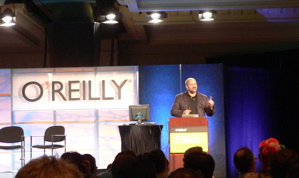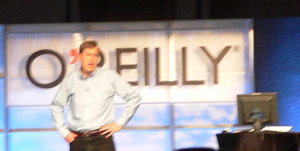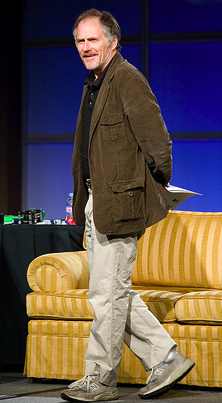“Fun is a chemical response. It comes from the same place as chocolate and orgasm,” said Raph Koster, game developer. According to one researcher he cited, there are four types of fun: hard, easy, visceral, and social. Games, he said, are mostly hard fun. Raph then moved into telling us how magic works. “It’s about structure,” he said. “It’s the same in nature, physics, and social media.” Another word for structure is grammar, he said. “All it means is how things fit together. It’s not a bad word.” He showed slides of the structure of blues music — and even sang us some blues — telling us songs are really made up of other songs, overlapping. And visual compositions are made up of spaces.  Similarly, games are made up of games — lots of little ones are in any good game, he said. Building games is about good “interaction design.” Then he ran us through a quick lesson in designing for fun, or applying game design to, for example, social media applications. He said you should have statistical features and opportunities for competition. “Never start an interaction with no context,” he said. And the participant must be able to prepare for the next encounter. Users should be able to solve challenges with a choice of tools, he said. “Reward them with different feedback. Variable feedback keeps things lively. And it should be visible to everyone.” Raph closed by telling us to check out his book site for more: www.TheoryofFun.com.
Similarly, games are made up of games — lots of little ones are in any good game, he said. Building games is about good “interaction design.” Then he ran us through a quick lesson in designing for fun, or applying game design to, for example, social media applications. He said you should have statistical features and opportunities for competition. “Never start an interaction with no context,” he said. And the participant must be able to prepare for the next encounter. Users should be able to solve challenges with a choice of tools, he said. “Reward them with different feedback. Variable feedback keeps things lively. And it should be visible to everyone.” Raph closed by telling us to check out his book site for more: www.TheoryofFun.com.
Tag: ETech (Page 2 of 3)
The opening session this morning was by Mike Kuniavsky, a user experience consultant who recently founded ThingM and previously founded AdaptivePath. ThingM he described as a “ubiquitous computing design studio.” The dream of Xerox Parc for ubiquitous computing, he said, is now a reality. “It’s today where the web was in the early ’90s.” But designing for it is different, he maintains.  Magic is a good metaphor, “a useful abstraction … because it does not cripple — it explains.” Magic to him is about the interaction you have with an object.
Magic is a good metaphor, “a useful abstraction … because it does not cripple — it explains.” Magic to him is about the interaction you have with an object.
“The age of magic is coming. It’s an inevitable byproduct of market forces and embedded computing,” said Kuniavsky. He said there are several terms used to describe the latter: ambient intelligence, pervasive computing, ubiquitous computing. “They’re all about embedded processors in everyday objects.” His definition of magic is a metaphorical relationship involving enchanted objects. He gave the example of “wands,” which we already see in technology products. The audience questions brought out some interesting discussion. The speaker emphasized that people are the conduit in this new age, essentially now the magicians — that this is about “the democratization of magic.” What about design by users, a la MySpace — can magic be done by them? “Sure. It’s about level of usefulness, not polish.”
Covering a lot of ground here this morning, in three wildly varying sessions. The first was Werner Vogels of Amazon giving a pitch on “Web-Scale Computing Architecture” provided by — what else? — his firm’s Amazon Web Services (AWS) platform. Nothing new here, as others have commented, but he had a couple of users on stage to give reports.  He cited a recent 37Signals book on how to do a Web 2.0 startup, which has a chapter entitled something like “Scale Later – Because It’s Really Hard.” That, of course, plays right into why you should let AWS worry about such things. “Focus on your idea,” said Werner, “and let our web-scale computing services meet infinite demand, cheaply and effectively.” A customer from RightScale.com, Thorsten von Eicken, said he’s been “running his service on Amazon for six months and will never go back.” Doug Kaye, CTO of Gigavox Media, said the service “has been big for us,” and that the price is right: his firm’s bill from Amazon for the first two months was only $84. “How great is that for a startup?”
He cited a recent 37Signals book on how to do a Web 2.0 startup, which has a chapter entitled something like “Scale Later – Because It’s Really Hard.” That, of course, plays right into why you should let AWS worry about such things. “Focus on your idea,” said Werner, “and let our web-scale computing services meet infinite demand, cheaply and effectively.” A customer from RightScale.com, Thorsten von Eicken, said he’s been “running his service on Amazon for six months and will never go back.” Doug Kaye, CTO of Gigavox Media, said the service “has been big for us,” and that the price is right: his firm’s bill from Amazon for the first two months was only $84. “How great is that for a startup?”
Jane McGonigal of Avant Game gave a fascinating talk on “Creating Alternate Realities.” She spoke of the three realms of happiness: pleasure, engagement, and meaning, and how the gaming industry can deal with these, even suggesting that making improved quality of life should be a priority.  “The new games are supergames,” she said. “They have massive scale, they are a superimposed hybrid experience, they’re super heroic, and they’re supercomputing.” What does all this have to do with the three realms of happiness? “They make you feel a part of something bigger, that you’re making meaning,” said McGonigal. Her talk closed with her ETech call to action: “Understanding and innovating happiness is the new capital. Hack happiness!” she said. And she told everyone to check out www.AvantGame.com/happiness. (I hope that link works for you, because it doesn’t for me yet.)
“The new games are supergames,” she said. “They have massive scale, they are a superimposed hybrid experience, they’re super heroic, and they’re supercomputing.” What does all this have to do with the three realms of happiness? “They make you feel a part of something bigger, that you’re making meaning,” said McGonigal. Her talk closed with her ETech call to action: “Understanding and innovating happiness is the new capital. Hack happiness!” she said. And she told everyone to check out www.AvantGame.com/happiness. (I hope that link works for you, because it doesn’t for me yet.)
The last big presentation of the morning was by Jeff Hawkins, cofounder of Numenta, and late of Palm and Handspring fame. His latest company is about neuroscience and traces back to a book he wrote a couple of years ago, “On Intelligence.”  A new friend I just met, Alex Iskold, wrote a post about Numenta this morning on Read/Write Web, which I discovered about 7:00 am when I went online in the hotel lobby. (And I see it’s already been Dugg about 500 times.) Hawkins said there’s no computer today that you can ask, “What is this picture?” But he’s working on that problem of visual perception, as well as a number of others, with a platform that’s based on a theory of how the neocortex works — Hierarchial Temporal Memory. The platform is called NuPIC, and, said Hawkins, “It works. We already have several customers.” He stated that the technology is especially of interest to companies in industries such as automotive, gaming, network modeling, drug discovery, vision systems, market analysis, and business modeling. The future? He said likely uses will be in music, language, and robotics.
A new friend I just met, Alex Iskold, wrote a post about Numenta this morning on Read/Write Web, which I discovered about 7:00 am when I went online in the hotel lobby. (And I see it’s already been Dugg about 500 times.) Hawkins said there’s no computer today that you can ask, “What is this picture?” But he’s working on that problem of visual perception, as well as a number of others, with a platform that’s based on a theory of how the neocortex works — Hierarchial Temporal Memory. The platform is called NuPIC, and, said Hawkins, “It works. We already have several customers.” He stated that the technology is especially of interest to companies in industries such as automotive, gaming, network modeling, drug discovery, vision systems, market analysis, and business modeling. The future? He said likely uses will be in music, language, and robotics.
Update: To add tags below.
It was getting late — for me, anyway, having flown in from “back east” as they say here in Cal. But, before I faded, I managed to catch part the opening evening sessions of the Emerging Technology Conference on Monday evening. I joined it in progress, after a great dinner with fellow bloggers Steve Borsch and Marc Orchant at a place called Buster’s Longboard Bar, which was full of surfing decor and photos. I was lovin’ it. (And the shark fish tacos were excellent.)  But I then managed to slip into Tim O’Reilly’s session called “O’Reilly Radar” and was glad I did, because he uncorked a great new definition of Web 2.0 … at least one I hadn’t heard yet.
But I then managed to slip into Tim O’Reilly’s session called “O’Reilly Radar” and was glad I did, because he uncorked a great new definition of Web 2.0 … at least one I hadn’t heard yet.
“Web 2.0 is not over and out yet,” he said. And he went on to to describe what now distinguishes Web 2.0. This is O’Reilly’s definition:
“Systems that harness network effects to get better the more people use them.”
I think that’s a great way to freshen up what’s become a bit of a tired term for many. Thank you, Tim! He went on to touch on a few companies that ostensibly fit this definition … or are poised to, anyway: Freebase, an open/shared structured database of the world’s knowledge … personal financial management site Wesabe (O’Reilly mentioned his firm is an investor) … and a stealthy investor market intelligence company called Mint.
“Web 2.0 is moving from consumer to mainstream business,” O’Reilly said. He ended his talk with a request of the audience: “Let us know when you see people having a lot of fun with technology. We want to know.” That’s a key reason so many people turn out for this event, I’ve decided — to learn what’s new and what’s fun. I think that’s great.
Speaking of which, Tim’s talk was followed by an absolutely fabulous magician act — actually, a “mathamagician” — named Art Benjamin. To say he wowed this largely developer crowd was an understatement. The guy was amazing, had lots of willing audience participants get up on stage, and got applause like you couldn’t believe. But, he was so good, he was making my brain ache. I was fading fast. So, off to the room I went, figuring I’d naturally be up way early and could blog then without falling asleep at my Powerbook. The first day’s sessions start in an hour or so.
Update: Forgot the photo credit. It was shot by Duncan Davidson and is from his Flickr set tagged “ETech.”
I’m off on an adventure tomorrow morning, flying to San Diego again, this time for the O’Reilly Emerging Technology Conference, where I’ll be reporting for Conferenza and posting to this blog. I’m looking forward to running into some old friends, and to an exciting program. The “magic” theme this year should be fascinating, based on the descriptions of some sessions I’ve highlighted below.

What technologies are “poised to blast off into the realm of magic?” O’Reilly asks, as it launches its sixth annual eTech event. [It will be the third one I’ve reported on, by the way.] The goal is to “balance pie-in-the-sky theorizing with practical, real-world information and conversation,” says the firm. The format consists of tutorials, breakout sessions, keynotes, and that most revered form of interaction — hallway conversations! — which “will hopefully spark enough unconventional thinking to change how you see your world.” 
The dates are Monday, March 26 through Thursday, March 29, and the venue is the Manchester Grand Hyatt right on the harbor in downtown San Diego. The promise, says O’Reilly, is for you to be able to learn which areas of technology have sufficiently advanced to the level of magic. So, I’m joining more than 1200 technologists, CTOs, hackers, researchers, thinkers, strategists, entrepreneurs, business developers, and VCs that are expected to participate in this year’s event.  I know from years past that the attendees at eTech are top notch — many leading developers, trendsetters, founders, and VCs (definitely a lot names you’d recognize). The strength of eTech, according to O’Reilly, is how it “taps into the creative spirit of all attendees, sparking provocative encounters and productive inspiration that continue long after the conference ends” — and I agree based on personal experience. In addition to the variety of sessions and extra-curricular activities, eTech has an exhibit hall featuring a focused group of about 14 exhibitors and sponsors.
I know from years past that the attendees at eTech are top notch — many leading developers, trendsetters, founders, and VCs (definitely a lot names you’d recognize). The strength of eTech, according to O’Reilly, is how it “taps into the creative spirit of all attendees, sparking provocative encounters and productive inspiration that continue long after the conference ends” — and I agree based on personal experience. In addition to the variety of sessions and extra-curricular activities, eTech has an exhibit hall featuring a focused group of about 14 exhibitors and sponsors.
eTech Sessions That Especially Sound Good
So, what are some the talks I’ve flagged out? On the first full day, Tuesday, I plan to catch as many of these as I can (some overlap each other, unfortunately):
• Building a “Web-Scale Computing” Architecture to Meet the Variable Demands of Today’s Business (Amazon Web Services)
• Making Offline Web Applications a Reality (Zimbra)
• Movie Magic: Coming Soon to the Real World Near You (Apple Computer)
• Flickr for Office Docs – Content Syndication through ThinkFree Doc Exchange
• RSS Beyond Blogging – Connecting Applications With Feeds (nSoftware)
• Digital Disney: the Mainstreaming of Web 2.0
• Successful Open Communities on the Internet (Wikia)
• Extreme Productivity in the Enterprise: The User is the Developer is the User (BEA)
• The Myths of Innovation
• Virtualizing the Datacenter with Project Blackbox (Sun)
Then, on Wednesday, we start getting heavier into that magic thing:
• The Coming Age of Magic (ThingM) – Excerpt: “The desktop metaphor is dead … Interaction design is significantly trailing the capabilities of the technology because of how difficult it is to explain what all this new stuff does … The desktop metaphor was useful for twenty years as a way to structure and explain information-processing technology. I propose “magic” as a metaphor for structuring interactions with embedded information processing technology …”
• The Role of Ubiquitous Web 2.0 Technologies in Everyday Life (Danah Boyd) – Excerpt: “While the ‘radical’ practices of young people and the organizational fetishes of technologists are certainly a curiosity to be examined, the real shift is happening in the lives of everyday people without an ounce of reflexivity …”
• Patterns: From Fabrics to Fabrication – Excerpt: “Today, the re-emergence of craft is part of the DIY movement that is discovering new tools for personal fabrication.
And here’s my vote for best named session:
• Scalability: Set Amazon’s Servers on Fire, Not Yours (SmugMug) – Excerpt: “With companies like SmugMug, Flickr, and YouTube growing by leaps and bounds, storage is a vital but expensive ingredient. Building, scaling, and managing large storage installations is cash — and labor –intensive. Amazon provides a simple API that exposes their internal storage architecture at utility prices. Suddenly, anything is possible. Unlimited, always-on storage everywhere in the world.”
• Sufficiently Advanced Magic (MIT Media Lab) – Excerpt: “…magicians and scientists often play on the same borders of the unknown. Magicians, however, do not have to kowtow to the constraints of reality as technologists do … If technology is man’s search to express control over his environment, scientists should look to magicians for inspiration and guidance as to what has engaged people for millennia … they continue to be successful by adapting their techniques and presentations in order to affect people profoundly.”
• Engaging with Web 2.0 Outside the Browser (Adobe) – Excerpt: “Web 2.0 is more than a social networking phenomenon. It’s a renaissance in web development … Rich Internet applications (RIAs), which break out from the traditional page-based web paradigm and currently run in the web browser, will soon be able to run on the desktop, both on and offline, with the ability to access local data and use web services to present an integrated and unique user experience … best practices and techniques that leverage existing web development skills to build and deploy Web 2.0 applications that bridge the Web and desktop … a new application model for content delivery and collaboration … how HTML, JavaScript, PDF, and Flash are coming together in a new project, code-named Apollo.”
• Pipes: A Tool for Remixing the Web (Yahoo!) – Excerpt: “Developers can use Pipes to combine data sources and user input into mashups without having to write code.”
• Web Scale Computing (Amazon Web Services) – Excerpt: “Web 2.0 business models are about competing on ideas, not on resources. Yet over 70% of most startup development effort goes into undifferentiated “heavy lifting”! … Using AWS, developers can build software applications leveraging the same robust, scalable, and reliable technology that powers Amazon’s retail business … 200,000 developers have registered on Amazon’s developer site to create applications based on these services.”
• Ajax Unplugged: Architecture and Tips for Taking Your Applications Offline (Zimbra) – Excerpt: “Looking back, 2006 may have been the year of Ajax … But despite its game-changing hype, Ajax is limited in its usefulness, it only helps people when connected to the Web. Surprisingly enough, people want access to their applications even when they aren’t connected to the Internet …”
And…drum roll…my vote for the funnest sounding session at eTech:
• 1/2 Baked (panel: 500 Hats, Feedburner, First Round Capital, August Capital) – Excerpt: “Half-Baked Dot Com is a participatory exercise in entrepreneurial improv theatre conducted by five teams of startup addicts and judged by an estranged panel of venture capitalists…or several crackpots and D-list bloggers, whomever shows up first … Half-Baked is the latest Web 2.0 craze that’s sweeping the un-conference circuit. Show up early and bring your A-game if you’d like to participate, otherwise bring your camera to record the heinous crime perpetrated on an audience who paid good money to attend this event.”
Finally, on Thursday, I’m seeing several more sessions that I’d like to catch — if I can hang around that long before hittin’ the waves:
• Apollo: Bringing Rich Internet Applications to the Desktop (Adobe)
• Silicon is Invading Medicine (Andy Kessler)
• Lessons Learned in Scaling and Building Social Systems (Yahoo!)
• Web 20-20: Architectural Patterns and Models for the New Internet (Adobe)
• Your Web App as a Text Adventure (Stikkit)
• Web Feed Workflows – Getting the Right Information, to the Right People at the Right Time (Attensa)
Let me know your thoughts about the sessions above, questions you’d like answered, etc. Watch for my blog posts and Flickr pix, too. And, by all means, if you’ll be at eTech yourself, please look me up!

Recent Comments